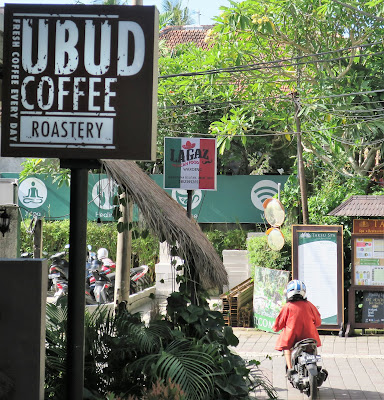At the temple in the main street of Ubud another festival is taking place and the traffic is crazier than usual. Late afternoon, a thunder storm brewing in the distance, and the rice paddies are calling.

So this is a short stroll along Jalan Kajeng, which leads, as the sign says, to the rice fields. At this end the street is busy with motorbikes.
The street is paved with signed concrete blocks and decorated with inlaid river stones. Lots are signed by individuals, families and businesses, and they mostly date from around 2002. How many of those who contributed still walk over their signatures?
At the start of the street there are the usual businesses - guest houses behind walls with decorated gateways, spas, shops selling arts and crafts, places for cooking classes and painting lessons.

The base for Ubud Botany Interactive looks a bit derelict, and the Ubud Sari Health resort doesn't look all that well either - but in this climate, moss grows on everything. I'm sure it is lovely once past the entry.
My favorite shop of this short street is Threads of Life. It is part shop, part gallery, and part textile museum; and they also offer classes and workshops. (These seem to be for groups. Anyone keen on a textile tour?) As well as textiles from different regions of Indonesia, there are examples of traditional basket weaving and other crafts. They support women in the more isolated and remote areas of the islands, encouraging cooperatives that allow them to pursue their traditions and earn an income at the same time, and they help to support highly skilled artisans to pass on and preserve their knowledge.
After this, my path leaves the street, though unfortunately the passing motorbikes only thin out marginally.
The path follows the irrigation channels between the fields. Peace descends and the air is fresher. Here and there, fallow fields are being cleared of the water weeds in preparation for the next planting. These fields are a feat of engineering that have endured for centuries and are still managed in the same way as they have been through the decades. Its a cooperative system that is defined by watershed rather than by politics. I'm intrigued by the strength of the walls that define each small field. How did they work out exactly how wide they need to be to maintain strength through wet and dry seasons?
- a resilient system of bottom-up management that both increases and equalizes harvests (Adaptive self-organisation of Bali's rice fields).
- in Bali, water is regarded as a public good, the gift of the Goddess of the Lakes.

 My destination - a restaurant surrounded by the paddy fields. So what'll it be for early dinner? Check out the meal at the end of this post. Meantime those storm clouds are looking interesting. Utter peacefulness and timelessness. Distant thunder is the only sound.
My destination - a restaurant surrounded by the paddy fields. So what'll it be for early dinner? Check out the meal at the end of this post. Meantime those storm clouds are looking interesting. Utter peacefulness and timelessness. Distant thunder is the only sound. The expat hunger to live in a villa in the countryside is eating into the arable land, but who wouldn't want to live in a location like this?
 |
| Nasi campur with lots of herbs. Organic red rice. Of course - this is Ubud. |


































